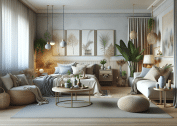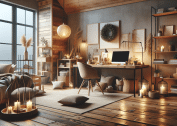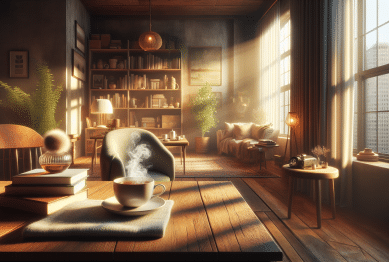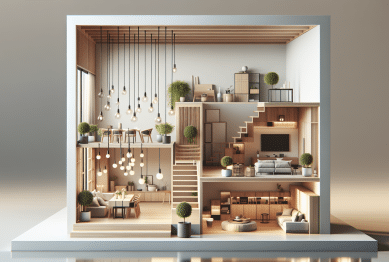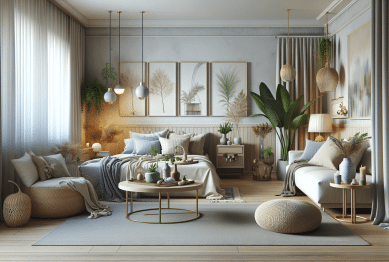Looking for effective ways to transform your living space into a calm sanctuary? Discover practical tips that blend home design trends, wellness routines, and mindful organization to help anyone create a more relaxing environment. Explore how décor and mood lighting can influence your daily sense of peace and comfort.
Why Home Ambience Matters for Your Wellbeing
Home is more than just walls and furniture; it’s where daily life unfolds. The ambience you cultivate in your space can greatly influence mental clarity, emotional balance, and even physical wellness. According to research from the National Institutes of Health, a well-maintained and pleasant environment is associated with lower stress levels and improved quality of life (https://www.ncbi.nlm.nih.gov/pmc/articles/PMC6073160/). Whether it’s the soft glow of accent lighting or the warmth of carefully chosen textiles, curated spaces directly affect relaxation. Small shifts in everyday surroundings can have a profound impact, helping everyone unwind after demanding days and encouraging mindfulness at home.
Science increasingly confirms that sensory cues—such as soft lighting or calming scents—can shape both mood and mental health. When spaces are cluttered, chaotic, or poorly lit, it becomes harder to relax or focus. For instance, interior design trends now emphasize the relationship between color, light, and emotional response. Gentle hues like blues and greens are often recommended for bedrooms and living areas because they elicit tranquil feelings. Curious about mood lighting? Studies from the University of Minnesota reveal that adjustable lighting can help regulate sleep cycles and enhance evening relaxation (https://www.takingcharge.csh.umn.edu/lighting).
There’s a reason wellness experts advocate organizing and decluttering regularly. Visual clutter is linked to higher cortisol levels, which is the body’s primary stress hormone. An orderly environment supports a clearer mind, while personalized touches—like cherished artwork or family photos—foster a sense of belonging. Building a calming home is not about achieving perfection but about making steady, accessible changes that nurture your own wellbeing. Want more insights? The American Psychological Association details how our environments affect everyday wellbeing (https://www.apa.org/monitor/2019/01/ce-corner-environment).
Designing Spaces for Calm: Color, Texture, and Light
Color psychology is a powerful tool for creating a more serene home. Blues, greens, and muted earth tones naturally encourage relaxation. Designers suggest integrating these shades in wall colors, linens, and accessories for their calming influence. Sleek, minimalist designs can also reduce visual noise, enhancing the sanctuary-like feel of any room. Textures play a role too; soft throws, smooth wood surfaces, and tactile rugs give comfort. According to the International Association of Color Consultants, these elements interact to reduce stress and promote feelings of security (https://iaccna.org/).
Mood lighting has emerged as a major trend, and for good reason. Adjustable lamps, warm-toned bulbs, and even candles are often used to establish zones of coziness. Floor and table lamps create pockets of light that can be adapted as needed, reducing strain and encouraging rest after busy days. Research from the Sleep Foundation finds that warm lighting in bedrooms promotes healthier sleep routines and a gentler transition from waking to rest (https://www.sleepfoundation.org/bedroom-environment/lighting-sleep). Even small investments in dimmable fixtures can make a noticeable difference.
Decor trends consistently highlight the connection between sensory comfort and mental tranquility. Soft window treatments, plush pillows, and thoughtfully arranged spaces can all help moderate overstimulation from daily life. Natural light remains a hero in the design world; maximizing it through sheer drapes or strategically placed mirrors enhances positive energy and lifts mood. Incorporating small planters or nature-inspired accents can add a finishing touch, grounding the home in subtle, soothing elements.
Decluttering: More Than Just Tidying Up
Decluttering is not just about discarding old possessions; it’s a lifestyle reset. When a room is organized, it sheds a psychological weight. Clutter tends to distract and foster anxiety, while order improves focus and engenders peace. Minimalist home organization ideas are increasingly sought after, as people recognize that streamlined settings make way for creative energy. According to The University of Connecticut, organized spaces are closely linked to improved concentration and productivity (https://today.uconn.edu/2022/05/another-benefit-to-decluttering-better-mental-health/).
Some suggest using a room-by-room approach, which avoids overwhelm and helps establish new maintenance habits. For example, setting aside just 15 minutes each day to remove unnecessary items or tidy a single corner fosters consistency. It’s useful to focus on surfaces first—countertops, desks, tables—since these attract the most visible clutter. Storage solutions, such as baskets or decorative boxes, provide both beauty and function, concealing mess while keeping essentials handy. These strategies bridge aesthetics and utility, supporting a soothing environment without sacrificing practicality.
Technology, too, can help. Popular lifestyle apps now offer guided decluttering challenges and reminders, keeping users accountable and motivated. Digital minimalism is an emerging trend, encouraging people to organize files and reduce smartphone notifications as part of their overall calm. As the National Association of Productivity & Organizing Professionals highlights, headline-making decluttering projects are less important than sustainable routines that integrate into daily life (https://www.napo.net/page/NAPOWebinars). When decluttering becomes habit, a home’s ambience naturally radiates tranquility.
The Role of Scents, Plants, and Soundscapes
Aromas have a powerful effect on stress levels and emotional states. Subtle, natural scents—like lavender, vanilla, or eucalyptus—are regularly used in wellness routines to promote relaxation. Diffusers or soy candles with calming notes can set the mood and encourage mindful breathing. According to the Mayo Clinic, certain essential oils may help reduce anxiety when used appropriately (https://www.mayoclinic.org/healthy-lifestyle/consumer-health/expert-answers/aromatherapy/faq-20058566). It’s essential to opt for gentle, allergy-friendly options suited to the whole household.
Bringing greenery indoors is another popular tactic for boosting wellness. Houseplants don’t just beautify a room—they can improve air quality and serve as natural mood lifters. Choices like snake plants, pothos, or peace lilies are low-maintenance and suited to most light conditions. Harvard Health Publishing notes that exposure to indoor plants may reduce psychological stress and provide a small but meaningful uptick in daily happiness (https://www.health.harvard.edu/blog/houseplants-can-they-improve-your-health-2019021916013).
Soundscapes—curated background audio such as soft music or nature sounds—are increasingly woven into home environments. Streaming platforms now offer playlists tailored for relaxation, yoga, or focus. Even a simple water fountain can bring gentle, soothing ambiance to a corner. Studies referenced by the American Psychological Association indicate that exposure to nature sounds or calming music lowers stress and enhances perceived comfort in home settings (https://www.apa.org/monitor/2020/04/nature-sounds). Combining scent, plants, and sound can create a multi-sensory haven.
Rituals and Routines to Support Daily Relaxation
Designing a relaxing home goes beyond décor; routines and rituals support long-term wellbeing. Evening wind-down routines—such as dimming the lights, sipping herbal tea, or reading a book instead of scrolling through a phone—signal the mind that it’s time to rest. Actionable habits like these, backed by sleep experts from the Sleep Foundation, can improve sleep quality and promote restorative downtime (https://www.sleepfoundation.org/sleep-hygiene/bedtime-routine).
Small daily rituals—morning journaling, gentle stretching, or practicing gratitude—shift focus away from outside chaos. Mindfulness routines strengthen the connection between the home environment and internal calm. Adding affirmations in visible spaces, or using a gratitude jar, helps anchor positivity into daily life. Even chores performed mindfully—washing dishes, folding laundry—become opportunities to slow down, breathe deeply, and ground oneself.
Family or household members benefit from shared relaxation rituals. Weekly screen-free evenings, meal prep together, or group meditation foster bonds and collective calm. According to the Yale Center for Emotional Intelligence, consistent routines not only reduce anxiety but help families recover from daily stresses faster (https://www.ycei.org). By weaving mindful rituals into daily life, anyone can enhance the restful atmosphere cultivated through intentional home design.
References
1. National Institutes of Health. (2018). The impact of light and color on mood. Retrieved from https://www.ncbi.nlm.nih.gov/pmc/articles/PMC6073160/
2. University of Minnesota. (n.d.). How lighting affects wellbeing. Retrieved from https://www.takingcharge.csh.umn.edu/lighting
3. American Psychological Association. (2019). Environments and psychological health. Retrieved from https://www.apa.org/monitor/2019/01/ce-corner-environment
4. Harvard Health Publishing. (2019). Houseplants and health. Retrieved from https://www.health.harvard.edu/blog/houseplants-can-they-improve-your-health-2019021916013
5. Mayo Clinic. (2022). The benefits of aromatherapy. Retrieved from https://www.mayoclinic.org/healthy-lifestyle/consumer-health/expert-answers/aromatherapy/faq-20058566
6. Sleep Foundation. (n.d.). Lighting and sleep. Retrieved from https://www.sleepfoundation.org/bedroom-environment/lighting-sleep




